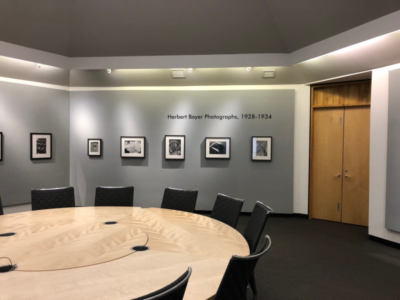
September 2018 – June 2019
In 1928, Herbert Bayer left his position as Master of Typography and Design at the Bauhaus in Dessau, Germany and moved to Berlin. He yearned to put his Bauhaus philosophy into practice, and experience what it meant to integrate art into all aspects of life, including commercial work. Upon his arrival in Berlin, he began working for Vogue Berlin and Dorland Studio, and proceeded to create some of his most formidable work with the photographic image playing an integral part of the composition.
Bayer was admitted to the Bauhaus in 1921. Although there were no photography workshops that Bayer could attend, he was introduced to the medium through the groundbreaking work of Laszlo Moholy-Nagy who began teaching at the Bauhaus in 1923. Upon taking his position, Moholy-Nagy promoted greater experimentation in all aspects of arts and education, emphasizing the reliance on new technology. He promoted a New Vision Photography that celebrated unconventional forms and practices in photography. Although Bayer did not experiment with the medium while at the Bauhaus, he did absorb the ideals of this mentor and friend.
The other major influence on Bayer’s exploration of the medium was his own wife, Irene, who encouraged him to experiment with the camera. The American-born Irene Hecht was a formally trained and technically proficient photographer. She began her preliminary coursework at the Bauhaus in 1925, where she met Bayer and married him later that year. She was concurrently taking photography courses at the Academy of Graphic Arts and Book Publishing in Leipzig. She assisted her husband in all aspects of his photography, while also pursuing her own career.
Before the Bayers settled in Berlin, they traveled with Marcel Breuer and Xanti Schawinsky to Southern France, where Herbert worked on a series of photographs exploring Pont Transbordeur in Marseille, on view in this exhibition. The photographs illustrate Bayer’s fascination with the geometry and angular perspective of the bridge – visual qualities that he was only able to realize with the use of the camera. Other photographs from this period are of everyday, mundane objects, abstracted to reveal an overlooked beauty in the simple composition of the elements. The objects transcend their function and are transformed into elegant abstracted shapes. In their spontaneity and immediacy, Bayer’s photographs invite the viewer to revel in a newfound formal beauty of his surroundings.
Bayer’s photographs of this period were neither physically manipulated in the dark room nor altered in any way. He continued to take photographs whenever he traveled, especially during a trip to Greece in 1934. He would go on to experiment further with the medium and create complex compositions made of multiple images that are cut, glued, drawn and reconstituted into new photographs known as fotomontagen and fotop/astiken. Bayer used these techniques to great effect in his advertising and graphic design work during his Berlin years, 1928-1938.
This exhibition of photographs, generously on loan from Jamie White and Andrew Sirotnak, and Paul Harbaugh, presents a selection of images Herbert Bayer created between 1928 and 1934, a time in which he was most prolific with the camera. Although he continued to use the camera throughout his life, he was never interested in continuing his work in photography as an art form. This small exhibition reveals yet another aspect of Bayer’s work that is less known and deserves to be better appreciated, not just as a moment in time, but how it was an essential part of Bayer becoming the complete artist and embodying the ideals of the Bauhaus.

